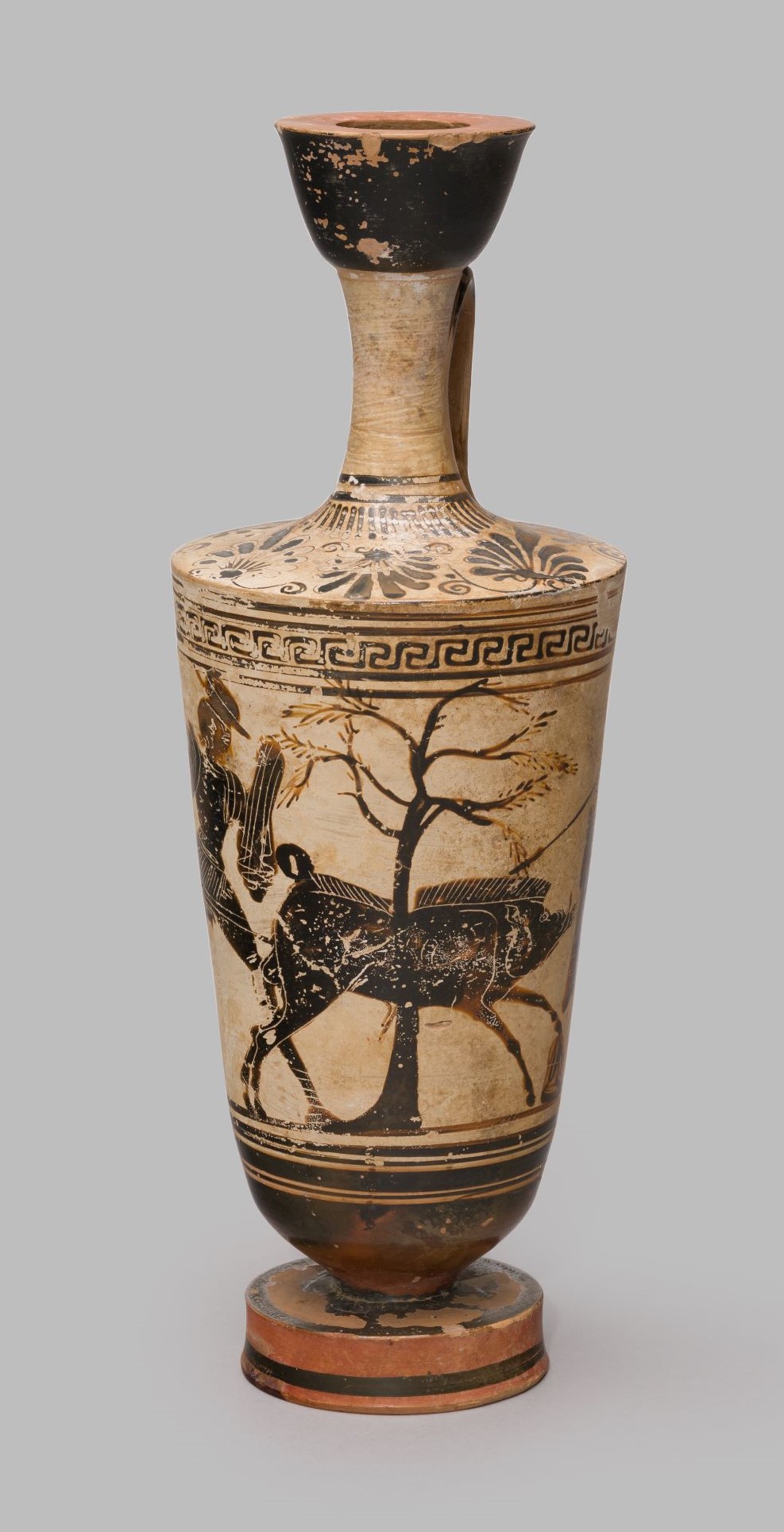
Lekythos [Gr33]
Athenian White-Ground, by the Beldam Painter, c. 470 BC
Painted Terracotta (h. 29.1 cm, d. 10.4 cm)
Two hunters spearing a boar, a tree behind. The hunter on the left wears a petasos, a short chiton with incised chevrons on the upper part, a chlamys and knee-length sandals. The hunter facing the boar is naked except for petasos and chlamys fastened behind his neck. The boar’s foot rests on a rock. On the shoulder five ten-leaved palmettes joined by tendrils. Below the shoulder key pattern between double lines.
This vase is painted in the white-ground technique, where the body of the vase was covered in a thin layer of pale clay before painting. The style appeared in Athens towards the end of the 6th century BC. It is closely associated with vases used in funerary rituals and given as offerings at graves, particularly lekythoi (oil vases) like this one. Many white-ground vases were decorated in multiple colours, but this example is painted using the black-figure technique. Detail is incised through the paint to the clay beneath.
Hunting was a popular pastime for upper-class Athenians. Like athletics, it was a masculine activity that served as training for war. A variety of game was hunted, but boar was a particularly prestigious and difficult quarry. In his treatise On Hunting, the Greek writer Xenophon (c. 430-354 BC) explains how to hunt boar, using dogs to drive them into a net or to chase them until they are exhausted. This vase shows the moment of maximum danger, when the huntsman prepares to spear the boar:
‘…the huntsman must approach him spear in hand, and grasp it with the left in front and the right behind, since the left steadies while the right drives it. The left foot must follow the left hand forward, and the right foot the other hand. As he advances let him hold the spear before him, with his legs not much further apart than in wrestling, turning the left side towards the left hand, and then watching the beast’s eye and noting the movement of its head.’ (Xenophon, On Hunting, X. 11-12)
The Beldam Painter was active in the second quarter of the 5th century, and was one of the last Athenian painters to work in the black-figure style. The painter’s name derives from a lekythos in Athens depicting an old woman (a beldam) being tortured by several satyrs.
Literature: J. Falconer and T. Mannack, Corpus Vasorum Antiquorum: Great Britain, Fascicule 19: Winchester College (Oxford, 2002), p. 12, plate 9.14-17; Judith M. Barringer, The Hunt in Ancient Greece (2001), p. 62 (no. 27); J.D. Beazley, Attic Black-Figure Vase-Painters (Oxford, 1942), p. 587.2; J. Chittenden and C. Seltman, Greek Art, a Commemorative Catalogue of an Exhibition held in 1946 at the Royal Academy, (London, 1947), p. 7 (no. 77); Winchester College Memorial Buildings: Department of Classical Art (Winchester, 1909), p. 18 (no. 47)
Exhibited: Royal Academy of Arts, Burlington House, London, 15 February – 17 March, 1946, no. 77
Provenance: From Eretria, at Winchester College by 1909
Location: Treasury, Gallery 3


